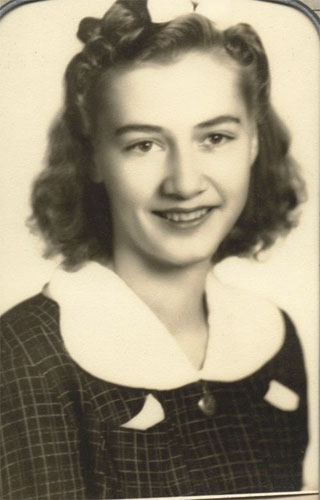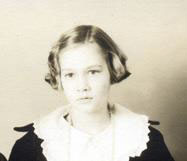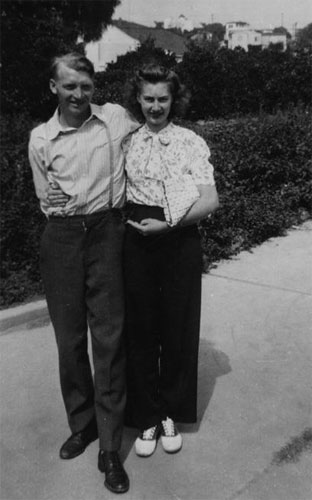
Lorraine Isackson Mills was born at her home in Happy Valley, along the Redmond Fall City Road, on October 24, 1925. Happy Valley is a small nook of a valley that runs from roughly 196th Avenue Northeast to 244th Avenue Northeast along the Redmond-Fall City Road. It's flanked to the north by Union Hill and to the south by the Sammamish Plateau. This area was at the time (and still is, to some extent, as this is written in 2002) farmland. In the 1920s and 1930s, there were mostly farms and logging in Happy Valley, and the entire population of this little nook was almost entirely Scandinavian.
Lorraine's father, Henry Isackson, was the son of thwo Swedish immigrants who had com eot America late in the 19th Century. Henry was born in 1895 in a two story log house located on what's now 244th Avenue Northeast. The house still exists — it was town down some years ago but was subsequently rebuilt near Snoqualmie Falls.
Lorraine's mother, Anna B. Magnusson, was born in Sweden in 1900 and immigrated to the Seattle area when Anna was about five years old. Her family settled in Union Hill, and part of the house she lived in still stands; the remainder of the house has been "remodeled around" by subsequent owners, and built into a large, attractive home.
During the First World War (1917-1918), Lorraine's grandmother Anna C. Isackson and other area women organized the Happy Valley Women's Club. They made articles, such as blankets, for servicemen. After the end of the war, the Club continued to make various items for people who might need them—cancer patients, for example. Lorraine's mothers and aunts joined the club, and eventually, so did Lorraine's. The Happy Valley Women's Club still exists in 2002. It presently has 11 members who meet once a month (except during the summer) for lunch. The members take up a collection each month, and at the end of the year, vote on a charity to give the funds to.
Henry Isackson enlisted in the army after America entered the First World War, but didn't go overseas for combat. Instead, the army put him in the "Spruce Unit". In the Spruce Unit, Henry logged large spruce trees which were used by the government in building planes used to fight in the war. After the war ended, Henry bought his own logging trucks and hauled logs for several logging companies. Bratanober Timber Company out of Seattle and Johnson Brothers were two companies that Loarraine remembered. At one time, Henry drove a 1916 Knox logging truck with three wheels — one wheel in the front, and two in the back; it had an enormous spoked steering wheel. He did much of his loogin in the Sahalee area, which in the 1920s was nothing but woods and logging roads. (Lorraine had fond memories of riding her horse when she was a girl along some of these Sahalee logging roads.) Henry would haul his logs down Inglewood Hill to a service station just north of the Inglewood Hill - East Lake Sammamish intersection. The building where the station stood, just on the west side of the road, is still there though it has long been abandoned. Below the service station Henry would dump the logs from a dock built for that purpose into Lake Sammamish, where they were gathered by a log boom and towed by boat to the Monohan Mill foarther south on the east side of Lake Sammamish.
Lorraine's parents, Henry and Anna, were married on June 30, 1923, and Henry bought some land in Happy Valley. Lorraine explained that much of the valley was originally "railroad land" — land that was give to the railroad in the 19th Century by the federal government in return for the railroad building tracks in the area. Lorraine did not recall any tracks ever being built in Happy Valley itself, though she said there were tracks during some of the 20th Century along the hills with trestles spanning canyons near Amos Lake. The tracks then ran farther east, perhaps as far as Carnation. The tracks were built for logging trains, which were used to haul logs that had been cut in the area.

The house where Lorraine was born in 1925 is still standing, though it's now used for storage. It's on the property now owned by her brother Lloyd, next ot the Isackson Mill. This property is located on the southwest corner of Redmond-Fall City Road and 244th Avenue Northeast, and the house is easily visible from the road. In Lorraine's youth, 244th Avenue was often called Isackson Hill, after her father. The Redmond-Fall City Road at that time was simply a gravel road, and would remain that way until the 1930s. For many years the Redmond-Fall City Road was the main route from Seattle to Snoqualmie Pass.
Lorraine was the first born in her family. Henry and Anna didn't have their second child until Lorraine was 14, so she was largely raised as an only child. But she didn't get lonely or bored — since she lived on a far, there was plenty to keep her busy. She milked cows with her mother, and the family also raised pigs and turkeys. They also had a large garden every year. Indeed, the Isacksons raised most of their own food.
Lorraine said the Redmond-Fall City Road wasn't paved until about 1936, and Puget Power didn't instll electric lines in Happy Valley until shortly after that time. Thus there was no electricity in the Isackson household during the 1920s or much of the 1930s. Since there was no electricity at there house until Lorraine was approaching her teen years, the Isacksons did not have a refrigerator or freezer during Lorraine's childhood. This wasn't unusual; many American families during this time didn't have refrigerators or freezers. These two items were still in the early stages of development during the 1920s and 1930s, and were a lot less available than they are today; in addition, they were much more expensive (in terms of 1920s and 1930s dollars) than they are now. As a result, food storage was a lot more difficult in those days.
So how WAS food kept? Lorraine said they canned a lot of their vegetables. In addition, the Isackson family had a "cooler", which was how many families in the days before refrigeration stored their perishables. A "cooler" was simply a cupboard in a dark, cool part of the kitchen. A vent was cut in the back of the "cooler" to let fresh air in and help keep the produce cool. A screen was placed over the vent to keep bugs out. This allowed families in the early 20th Century to keep non-canned food for several days, except in the summer. During the summer it was simply too warm to store anything other than canned goods. Later in the 1930s, the Isackson family got their first "ice box" — a large unit that looked like a store freezer, except it had no cooling system. To keep their food fresh, people bought blocks of ice in increments of 25, 50, 75, or 100 pounds and put it in the "ice box" to keep food cool. Although there were "ice wagons" (delivery trucks) that delivered blocks of ice in Redmond and Issaquah, Lorraine didn't recall whether or not the "ice wagons" came out as far in the country as she lived or if her father picked up ice when he went into town. The family cooked their food on a wood stove. A "copper coil" or "water back" was placed in the side of the stove's firebox, which circulated water from the water source, through the coils and into a hot water tank for storage, and then to the faucet. The water came into the house from a spring located on the hill above the house. The only water pressure came from gravity flow, and thus the water flowed at a slow trickle — not with the high pressure that we today when we turn on a faucet.
If the Isackson family needed anything else that they didn't grow or raise themselves, they went to the Redmond Trading Company in downtown Redmond (o Leary Way and Cleveland Street) to buy it. This was in an enormous store that touted itself in selling everything from "soup to nuts" — supermarkets were still years away in the 1930s. The Redmond Trading Company as lined with shelves of produce and merchandise from the floor to the ceiling — if you wanted something from a higher shelf, you had to get it with a ladder and a metal rod with "fingers". The Redmond Trading Company had board floors and an enormous pot bellied stove and the store was a favorite gathering place fo the locals. The Redmond Trading Company building still stands, though the Company itself went out of business years ago, probably in the 1940s, according to Lorraine.
Since there wasn't electricity in the Isackson household until the late 1930s, lighting was provided by kerosene lamps and an occasional gas lamp placed at strategic locations in the house. Heat was provided by the wood cook stove in the kitchen and a wood burning heating stove in the living room. This system later converted to oil and eventually to electricity.
There was no indoor plumbing in the Isackson household during ht e early years of Lorraine's childhood. There was first a shallow well with a hand pump that the Isacksons used for water; they simply took water from the well and hauled it back to their house. Later Henry Isackson discovered a spring some distance from their house and set up a line from the spring to the kitchen sink. As I mentioned earlier, the water had just enough pressure from gravity that it came out fo the faucet in a small trickle. Lorraine referred to this as "gravity flow water". Baths were taken in the kitchen by filling up a tub with gravity flow water. An outhouse behind the Isackson home served as the family bathroom.
In the 1930s, the Isacksons owned a Maytag washer with a gas motor. Washers were still a fairly new invention in the 1930s. Some other farm families in the area were still washing clothes the old fashioned way - in a tub with an instrument that looked remarkably like a long metal plunger, or with a washboard. Lorraine still has the tub and plunger that her aunt used earlier in the 20th Century. Clothes were hung out on a clothes line to dry or, if it was wet outside, laid out in a dry room. "We usually tried to pick a dry day to do the wash", she laughed.
Radio and the phonograph were the Isackson family's home entertainment center in the 1920s and 1930s. Their first radio was a battery operated Atwater-Kent radio. Since the radio was battery powered, the family didn't run it much — almost never during the day (they were too busy), but occasionally in the evenings, particularly if Amos and Andy was on. The Isackson's also had a wind up phonograph to play records — to start it, they simply wound the turntable with a hand crank. "78" records were the norm at that time, and got their name because they played on a turntable at 78 revolutions per minute. These records were about nine inches in diameter and considerably thicker than today's compact discs.
The Isacksons got their first phone in the mid 1930s. At that time, dial-up service (using a hand dial or "rotary" phone) was not yet available. To make a call the caller simply picked up the phone and waited until an operator picked up at the other end, then gave the operator the phone number of the person she was calling. By the late 1930s, though, dial service was available, thus eliminating the need for an operator, at least for local calls.
In 1936, Henry opened his own sawmill, called, appropriately enough, Isackson's Mill. (Lorraine's younger brother Duane is still running the mill in 2002, and is still using the original planer which is described below.) Business expanded rapidly, particularly after America entered the Second World War late in 1941. The larger commercial mills in Seattle became tied up with the war effort, and people needed the smaller area mills to get timber to build homes and other local structures. In addition, the sawdust produced by milling and planning the logs was often used by locals to heat their homes — coal was dirty and expensive, and oil was hard ot obtain during the Second World War.
As business increased at Isackson' Mill, Henry hired a second employee, Vernon Mills, who would become Lorraine's husband in 1943. Together Henry and Vern planed and edged much of the timber that you see in many of the buildings in the Redmond and Fall City area today. Lorraine said her father had one of the largest planers in this area. A planer was used to smooth and plane the logs into boards. The planer could also be used as an edger (to cut grooves into the boards). Lorraine said Henry got the planer from the Monohan Mill after the mill - but, luckily, not the planer - was destroyed by fire in 1925.

1943 was a big year ofr Lorraine. She graduated from high school in January of that year from Fall City High School. Soon after, she got her first job, as a secretary with Alaskan Copper in Seattle. In order to shorten her commute while she worked at Alaskan Coppers, she briefly lived with her grandparetnts in Kirkland. To get to tSeattle she took the ferry from the Kirkland Ferry Dock (now Lakeshore Point in Kirkland) to Madison Park, then a cable car to First Avenue South, where she transferred to a street car fo the ride to Alaskan Copper's office, also on First Avenue South. Lorraine recalled her pay as being 52 cents an hour. Later in 1943, she began working for the Lake Washington Shipyard in their personnel department. And, in November, 1943 she married Vernon Mills.
Lorraine and Vern lived briefly in Los Angeles in the late 1940s, but quickly returned to Happy Valley and settled there. Their daughter, Carol, was born in 1951. Vern had a love for horses and for raising beef cattle. For several years he and Lorraine raised animals on a ranch near Ellensburg, and trucked the animals to their home in Redmond during the winter months for feeding. He worked in the logging industry for many years, but got out of the business as the area logging industry began to wind down in the 1960s. He successfully operated a sercie station in Redmond for over 10 years, then worked for the state highway department, from which he retired. Vernon Mills died June, 2000. He and Lorraine had been married for over 56 years.
Lorraine worked in several different jobs in the late 1940s, but took a couple of years off in the early 1950s after Carol was born. A few years after Carol was born, Lorraine went to a state Grange meeting as a delegate from the Happy Valley Grange and was elected to a minor office. (The Happy Valley Grange was formed in 1907 as an agricultural organization. Today the Grange is particularly active in providing service to the community.). Two years later, Lorraine was elected as a State Grange Lecturer - the third highest office in the Grange. She served as Lecturer for 13 years, in charge of programs and helping to provide educational, recreational and inspirational materials for all the Granges in the State of Washington. By the mid 1950s Lorraine had also opened the Grange Insurance Agency in Redmond, which she successfully operated for 32 years, buying out a few smaller agencies in the process. Lorraine was also Secretary/Treasurer of the King County Grange Credit Union for 25 years. She's a 62 year member of the Happy Valley Grange.
Lorraine said that the changes she had seen in Happy Valley during her lifetime had been phenomenal. She said "When I was little, we had just a few gravel roads in this area. There were only a couple of houses within a few miles of where I lived. Now we've gone from a rural to an urban atmosphere, and many of my old friends and neighbors have moved away or passed on. But even with all the changes, there's nowhere else I'd rather live."
-Phil Dougherty
July, 2002
In the story, there is a reference to the Grange starting in 1907. That year should be 1909. - Phil Dougherty